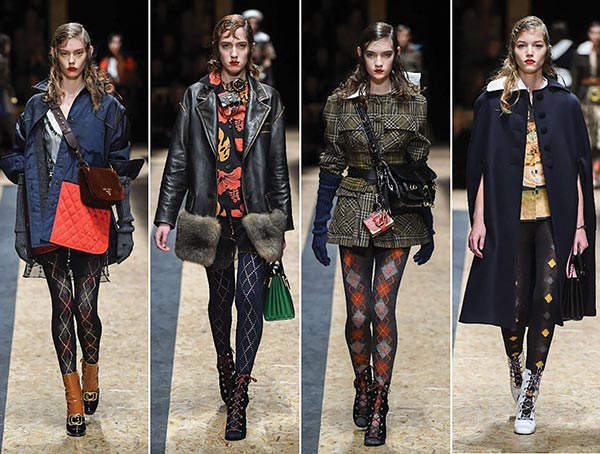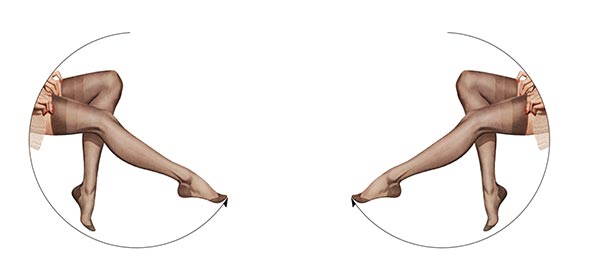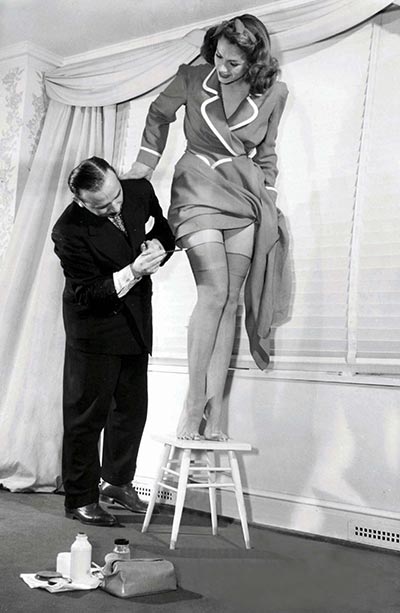
When the spring/summer 2017 runways said "yes" to pantyhose with open-toed shoes, it was viewed as yet another example of an old-turned-new trend – hosiery is certainly no longer atop most women's wish lists when it comes to fashion. But for much of the 20th century, it was an essential staple of a polished woman's daily wardrobe.
Pantyhose's famous predecessors were stockings, which reached up to the thigh and generally needed to be supported by a garter; these tights first became popular among men before women started to wear them in the 18th century. As a new style emerged in tandem with the change in women's social status in the 1920s, shorter skirts came into fashion, paired with stockinged legs – a trendy look of the day was a woman rolling her stockings down just below the knee and dusting rouge on the kneecaps. The enduring "fishnets" were introduced in the '30s; brands such as France's Gerbe, the UK's Charnos and Italy's Levante prospered during that period and continue to be at the forefront of hosiery style today.
In 1938, the invention of nylon in the United States revolutionised the industry. Initially used for toothbrushes, after nylon was introduced as a fabric at the 1939 New York World's Fair, nylon stockings became widely popular. Women swarmed stores to purchase the hosiery and four million pairs were sold in the first few days of their release. However, the Second World War meant that nylon was soon in short supply, as the fabric was sent to the battlefield in the form of tents and parachutes.

However, nothing can stop women from pursuing beauty. If they couldn't buy nylon stockings, someone figured out that they could paint them on. Leg cosmetics created a fashion storm during wartime, allowing women to do make-up from their toes to their thighs, thus achieving the illusion of real stockings. Liquids, lotions, creams and sticks were all used to mimic a noticeable sheen.
Numerous brands got on board with "canned hosiery", including Frances Denney (with Leg Make-Up Film), Revlon (Leg Silk), Helena Rubinstein (Leg Stick) and Harriet Hubbard Ayer (Stocking Lotion). There were even leg make-up bars, where women could purchase the cosmetics or get advice on how to apply them to their legs. Following the end of the war, though, nylon stockings were restocked on shelves and endless lines reappeared outside the hosiery shops.
There was only one problem – without squeezing into garters, there was no other way to hold the stockings up in the '50s. Among numerous patents filed, the waist-to-toe leg garment, which we now know as pantyhose, was invented by a man in 1959 who created it at the request of his then-pregnant wife, who found it difficult to manage her stockings and garter belt over her expanding belly.

But pantyhose didn't truly burst onto the fashion scene until the miniskirt craze of the '60s. Around the same time, tights were being produced by British manufacturer Aristoc and expanded in popularity after the invention of spandex, a synthetic fibre that allows leg garments to stretch. Another important innovation in 1977 came courtesy of an unusual source: Julie Newmar, the original Catwoman actress in the 1960s Batman TV series. She's credited with patenting a special type designed to accentuate a woman's behind – the "derriere-shaping" pantyhose. In 1977, Newmar famously explained to People magazine: "They make your derriere look like an apple instead of a ham sandwich."
In the '80s and early '90s, hosiery came in a wide range of colours, patterns and fabrics, and became the defining feature of a professional woman's daily style. However, as office dress codes became more casual, many women abandoned pantyhose and embraced the freedom of bare legs.
Fashion always goes in cycles, so it's not surprising that the spotlight has shifted back to pantyhose again in recent years – it's been seen on everyone from Hollywood stars to Her Royal Highness. In the last century, hosiery was not just an important part of a woman’s wardrobe, but also a statement of a proper lifestyle.
